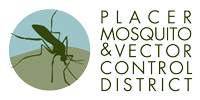
Biological control uses natural enemies to help manage mosquito populations. There are several types of biological control like the direct introduction of parasites, pathogens and predators to target mosquitoes. We use mosquitofish, Gambusia affinis, a predatory fish that feeds on mosquito larvae as a preventative biological control agent against mosquitoes to reduce mosquito larvae from a water source. Mosquitofish are applied by our trained technicians to sites where they are likely to be successful in controlling mosquitoes and unlikely to escape into natural bodies of water.
Mosquitofish
We produce mosquitofish at our Roseville facility as a preventative biological control agent against mosquitoes to reduce larvae from contained water sources like ponds, unmaintained swimming pools and animal water troughs. Many factors affect how well mosquitofish will work to minimize mosquitoes including the water’s condition, time of year, species of mosquito present and mosquitofish predators present. Mosquitofish generally reduce but may not eliminate mosquito larvae completely. Like other mosquito control materials, we do not give away mosquitofish directly to residents. If you are interested in mosquitofish, please submit a problem report to schedule an inspection.
Mosquitofish eat mosquito larvae as they hatch from eggs. Mosquitofish do not lay eggs but, instead, give birth to live young. They breed throughout the summer and new broods are produced at about six-week intervals. The young are about one-fourth inch in length when born and are ready to begin feeding immediately on mosquito larvae. Mosquitofish grow rapidly and reach a maximum length of about three inches. Depending on water quality and predators present, mosquitofish can overwinter and become active again in spring. Repeated applications of mosquitofish each year may not be necessary in many habitats. If you have mosquitofish on your property, no feeding or other care is necessary.
We are able to produce approximately 130 pounds of mosquitofish on an annual basis. Each pound of mosquitofish consists of about 450 individual fish. In the event that our in-house supply does not meet the needs of our residents, we are able to obtain fish from neighboring districts or harvest them from the wild. The District keeps a summer stock of mosquitofish and conducts property inspections of standing water sources from March to October to see if mosquitofish are the right treatment option.
To learn more, read our mosquitofish brochure here.
Dump & Drain Standing Water
All mosquitoes need some amount of standing water to develop from eggs to adults. Depending on land use and environmental considerations, manipulating the duration or location of standing water can eliminate mosquito development sites and reduce the number of adult mosquitoes that emerge. Sometimes, reducing aquatic or emergent vegetation, improving access for other control methods or shifting the timing of the standing water to a less favorable time for mosquito development can be effective at preventing mosquitoes. This is physical control.
Urban
Since all mosquito species need water to breed, source reduction can be as simple as emptying water from containers around the home. This is something that homeowners can accomplish easily and effectively. Some mosquito species only need a bottle cap of water to lay eggs.
- Drain and permanently remove unused plastic pools, old tires, plant saucers and buckets
- Clear clogged gutters
- Repair leaks around faucets
- Regularly change water in bird baths
- Drain puddles, swampy areas and tree stumps
Agricultural
We also work with landowners and land managers to limit standing water on their property. Placer County is known for its rice fields and agriculture. We conduct the below activities to help manage mosquito development in agricultural sites.
- Manage emergent vegetation
- Maintain ditches and natural drains
- Coordinate irrigation
- Plan mosquito treatments
Plan Check
Our physical control program also includes source prevention. We work with municipal and county planners and developers to review development plans and provide recommendations that limit standing water, emergent vegetation and ensure access for inspection and mosquito control when needed.






